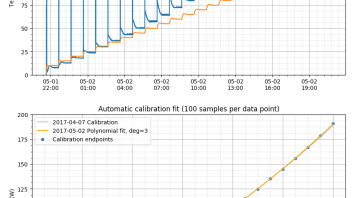Calibration graph made with the last data point in before the descending steps phase. It looks like the current calibration almost perfectly matches the previous one until the last two steps. I think a third degree fit works better here.

Here is the data. The power and temperature data points here are the average of the 100 samples preceding the indicated timestamps, except for the first one.
Time Stamp Heater Power (W) Tube (C-k)
2017-05-01 21:38:07.183550+00:00 1.7220428332672002e-05 17.942339999999998
2017-05-01 22:35:00.442770+00:00 7.664807786896651 100.0839074
2017-05-01 23:34:59.973660+00:00 12.644998846405777 150.01106800000002
2017-05-02 00:34:59.600540+00:00 18.133817051990818 200.39287689999995
2017-05-02 01:34:59.139421+00:00 23.896451427578167 250.0262765999999
2017-05-02 02:34:58.766310+00:00 30.18091099963513 300.00385389999985
2017-05-02 03:34:58.289190+00:00 36.64975614044998 349.97075779999983
2017-05-02 04:34:57.924080+00:00 43.37305085003351 399.99852180000016
2017-05-02 05:34:57.454960+00:00 50.315560292769334 449.9978108000001
2017-05-02 06:34:57.089850+00:00 57.39183947735066 499.9888697
2017-05-02 07:34:56.612730+00:00 64.87330223265138 549.9905457999998
2017-05-02 08:34:56.247620+00:00 72.47135871071728 600.0379964000005
2017-05-02 09:34:55.770500+00:00 80.6033403371504 649.9752067000002
2017-05-02 10:34:55.413390+00:00 88.5913023331697 700.480553399999
2017-05-02 11:34:54.936270+00:00 97.4853823143232 749.9825112999985
2017-05-02 12:34:54.571150+00:00 106.15427356512576 799.9729999999972
2017-05-02 13:34:54.142040+00:00 115.333362565592 849.957331099999
2017-05-02 14:34:53.688920+00:00 124.60688635248215 899.9522664999982
2017-05-02 15:34:53.307810+00:00 135.2208374344002 950.159078399998
2017-05-02 16:34:52.846690+00:00 144.98418170356058 999.9508285999997
2017-05-02 17:34:52.467570+00:00 155.74080537269398 1049.9104676999998
2017-05-02 18:34:52.012460+00:00 166.98754319927102 1099.973550000001
2017-05-02 19:34:51.631340+00:00 178.78322825757604 1149.1512001000003
2017-05-02 20:34:51.170230+00:00 190.72940516887724 1199.9968420000018
